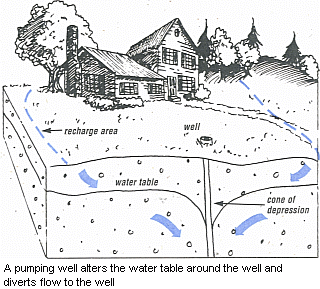Wells
Approximately one million of Connecticut’s three million residents depend on groundwater as the source for their drinking water. Half of them draw their groundwater from individual wells, half from community wells. Wells also supply industry and agriculture with some of their water.
Wells range from those drilled deeply into bedrock or stratified drift to the shallow hand-dug ones that have served the water needs of past generations. Most modern wells are 6-inch diameter holes drilled or driven 100 feet or more into the ground. In most cases the discovered groundwater is withdraw using a submersible pump.
The area immediately surrounding a well is particularly important. It is from here that groundwater is unnaturally induced to flow towards a well, creating a cone of depression in the water table. The land area that contributes water to the cone of depression is called the well recharge area and it varies in size and shape depending on the type of aquifer tapped and the yield of the well. A typical recharge area of a low-yield, residential well can encompass several acres; that of a large-yield, community well can be hundreds of acres.
Because the recharge area of a well is so important to the overall purity of well water, special care must be taken to protect this land. A basic understanding of groundwater flow enables us to delineate the recharge area of any well and design specific ways to prevent pollution from occurring within it. For example, aquifer protection areas are being established for the recharge areas of major public water supply wells located in stratified drift aquifers. These are receiving priority protection because the wells they replenish are the primary source of drinking water for thousands of people.
